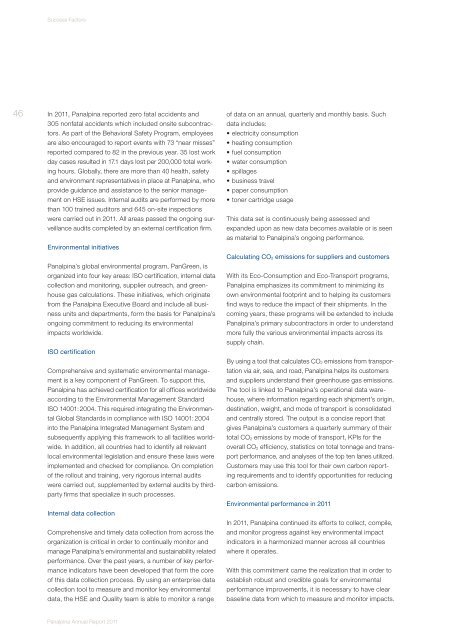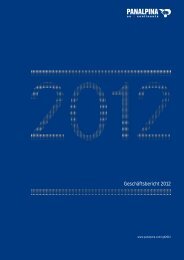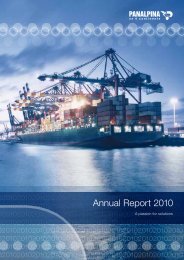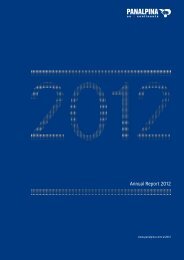Panalpina Annual Report 2011
Panalpina Annual Report 2011
Panalpina Annual Report 2011
Create successful ePaper yourself
Turn your PDF publications into a flip-book with our unique Google optimized e-Paper software.
46<br />
Success Factors<br />
In <strong>2011</strong>, <strong>Panalpina</strong> reported zero fatal accidents and<br />
305 nonfatal accidents which included onsite subcontractors.<br />
As part of the Behavioral Safety Program, employees<br />
are also encouraged to report events with 73 “near misses”<br />
reported compared to 82 in the previous year. 35 lost work<br />
day cases resulted in 17.1 days lost per 200,000 total working<br />
hours. Globally, there are more than 40 health, safety<br />
and environment representatives in place at <strong>Panalpina</strong>, who<br />
provide guidance and assistance to the senior management<br />
on HSE issues. Internal audits are performed by more<br />
than 100 trained auditors and 645 on-site inspections<br />
were carried out in <strong>2011</strong>. All areas passed the ongoing surveillance<br />
audits completed by an external certification firm.<br />
Environmental initiatives<br />
<strong>Panalpina</strong>’s global environmental program, PanGreen, is<br />
organized into four key areas: ISO certification, internal data<br />
collection and monitoring, supplier outreach, and greenhouse<br />
gas calculations. These initiatives, which originate<br />
from the <strong>Panalpina</strong> Executive Board and include all business<br />
units and departments, form the basis for <strong>Panalpina</strong>’s<br />
ongoing commitment to reducing its environmental<br />
impacts worldwide.<br />
ISO certification<br />
Comprehensive and systematic environmental management<br />
is a key component of PanGreen. To support this,<br />
<strong>Panalpina</strong> has achieved certification for all offices worldwide<br />
according to the Environmental Management Standard<br />
ISO 14001: 2004. This required integrating the Environmental<br />
Global Standards in compliance with ISO 14001: 2004<br />
into the <strong>Panalpina</strong> Integrated Management System and<br />
subsequently applying this framework to all facilities worldwide.<br />
In addition, all countries had to identify all relevant<br />
local environmental legislation and ensure these laws were<br />
implemented and checked for compliance. On completion<br />
of the rollout and training, very rigorous internal audits<br />
were carried out, supplemented by external audits by thirdparty<br />
firms that specialize in such processes.<br />
Internal data collection<br />
Comprehensive and timely data collection from across the<br />
organization is critical in order to continually monitor and<br />
manage <strong>Panalpina</strong>’s environmental and sustainability related<br />
performance. Over the past years, a number of key performance<br />
indicators have been developed that form the core<br />
of this data collection process. By using an enterprise data<br />
collection tool to measure and monitor key environmental<br />
data, the HSE and Quality team is able to monitor a range<br />
<strong>Panalpina</strong> <strong>Annual</strong> <strong>Report</strong> <strong>2011</strong><br />
of data on an annual, quarterly and monthly basis. Such<br />
data includes:<br />
�������������������������<br />
���������������������<br />
������������������<br />
�������������������<br />
�����������<br />
�����������������<br />
�������������������<br />
�����������������������<br />
This data set is continuously being assessed and<br />
expanded upon as new data becomes available or is seen<br />
as material to <strong>Panalpina</strong>’s ongoing performance.<br />
Calculating CO2 emissions for suppliers and customers<br />
With its Eco-Consumption and Eco-Transport programs,<br />
<strong>Panalpina</strong> emphasizes its commitment to minimizing its<br />
own environmental footprint and to helping its customers<br />
find ways to reduce the impact of their shipments. In the<br />
coming years, these programs will be extended to include<br />
<strong>Panalpina</strong>’s primary subcontractors in order to understand<br />
more fully the various environmental impacts across its<br />
supply chain.<br />
By using a tool that calculates CO2 emissions from transportation<br />
via air, sea, and road, <strong>Panalpina</strong> helps its customers<br />
and suppliers understand their greenhouse gas emissions.<br />
The tool is linked to <strong>Panalpina</strong>’s operational data warehouse,<br />
where information regarding each shipment’s origin,<br />
destination, weight, and mode of transport is consolidated<br />
and centrally stored. The output is a concise report that<br />
gives <strong>Panalpina</strong>’s customers a quarterly summary of their<br />
total CO2 emissions by mode of transport, KPIs for the<br />
overall CO2 efficiency, statistics on total tonnage and transport<br />
performance, and analyses of the top ten lanes utilized.<br />
Customers may use this tool for their own carbon reporting<br />
requirements and to identify opportunities for reducing<br />
carbon emissions.<br />
Environmental performance in <strong>2011</strong><br />
In <strong>2011</strong>, <strong>Panalpina</strong> continued its efforts to collect, compile,<br />
and monitor progress against key environmental impact<br />
indicators in a harmonized manner across all countries<br />
where it operates.<br />
With this commitment came the realization that in order to<br />
establish robust and credible goals for environmental<br />
performance improvements, it is necessary to have clear<br />
baseline data from which to measure and monitor impacts.






